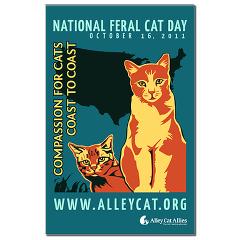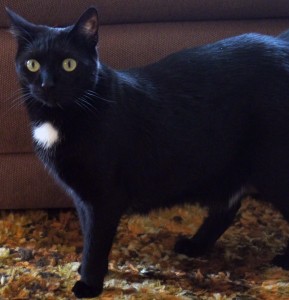Today is National Feral Cat Day and we here at The Tiniest Tiger’s Conservation Cub Club care for all cats big and small. Our Friends at Alley Cat Allies work hard to help our feral cousins and they also try to help humans learn the truth about our outdoor cats. Here are some of the facts from our friends at Alley Cat Allies.

Discover the Truth about Feral Cats
- Outdoor cats have existed alongside humans for 10,000 years. They are not a new phenomenon. Feral and stray cats live and thrive in every landscape, from the inner city to rural farmland.
- Feral cats are not socialized to people. And therefore, they are not adoptable. Feral cats don’t belong indoors and are typically wary of us. However, as members of the domestic cat species (just like pet cats), they are protected under state anti-cruelty laws.
- Feral cats should not be taken to pounds and shelters. Feral cats’ needs are not met by the current animal control and shelter system, where animals who are not adoptable are killed. Feral cats live full, healthy lives outdoors—but are killed in shelters. Even no-kill shelters can’t place feral cats in homes.
- Feral kittens can be adopted. Feral kittens can often be adopted into homes, but they must be socializedat an early age. There is a crucial window, and if they aren’t handled in time, they will remain feral and unadoptable.
My brother Mercy was a feral kitten pulled from an alley. He was socialized very young and now he is super sweet. In fact, he is so gentle and lovable he is my grandma’s favorite. She loves me too, but she is over the moon about Mercy.
- Feral cats live healthy lives in their outdoor homes. Feral cats are just as healthy as pet cats—with equally low rates of disease. They have the same lifespans, too.
- People are the cause of wildlife depletion. Studies show that the overwhelming causes of wildlife and bird death are habitat loss, urbanization, pollution, and environmental degradation—all caused by humans, not feral cats.
- Catch and kill doesn’t work. Animal control’s traditional approach for feral cats— catching and killing—is endless and cruel. Cats choose to reside in locations for two reasons: there is a food source (intended or not) and shelter. When cats are removed from a location, new cats move in or survivors breed to capacity. This vacuum-effect is well-documented.
- Trap-Neuter-Return does work. Trap-Neuter-Return (TNR) benefits the cats and the community. Cats are spayed or neutered, vaccinated, and eartipped (the universal symbol of a neutered and vaccinated cat), and then returned to their outdoor home. The colony’s population stabilizes—no more kittens! Trap- Neuter-Return improves their lives and improves their relations with the community—the behaviors and stresses associated with mating stop. Trap-Neuter-Return is the humane, effective approach for feral cats.
- You can make a difference and save lives. Together, we can educate people about feral cats and the fact that they don’t belong in pounds and shelters, and spread the word that TNR is the humane approach for them.
To learn more or to find tools to help, go to www.alleycat.org.
Thank you for caring and loving for all cats big and small!
MFVTJ8JRMGDQ

Thanks for posting, Gracey. Alley Cat Allies is my very favorite cat charity, and we try to advocate Trap/Neuter/Release everywhere we can.
All of my cats were found. One was feral and I didn’t know. He was all black and found in a snowstorm. Because of the snow, he didn’t have a lot to eat, so he was undernourished. The vet even got his age wrong. He was social to a point. He always wanted out, and all of our cats are indoor cats. He finally got outside, and I put up a shelter for him, and fed him outside.
Thank you for educating all of us about ferals. They really don’t do well in shelters, and the solution is TNR, as you stated.
Great post!!!!